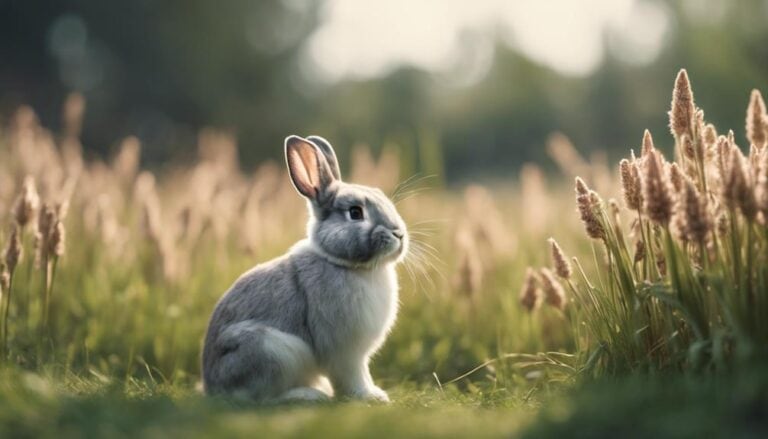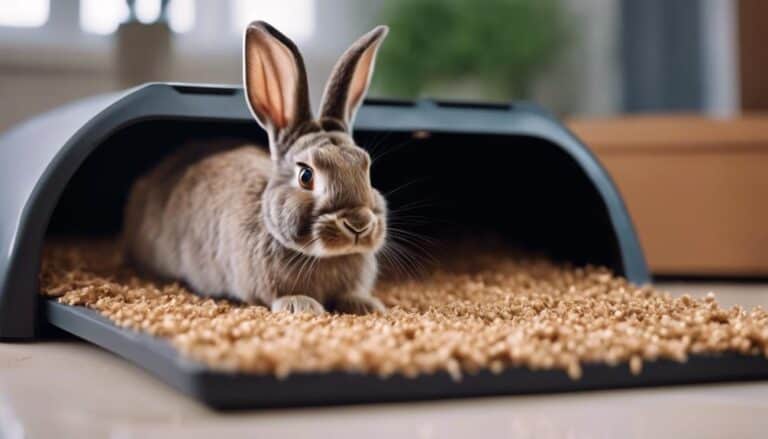You may have wondered whether bunnies hibernate, a common misconception due to their elusive winter behaviors.
However, the truth behind how bunnies navigate the cold season might surprise you.
Understanding the intricacies of their winter survival tactics sheds light on their remarkable adaptations and the challenges they face.
Stay tuned to uncover the fascinating world of bunnies in winter and how you can support these resilient creatures during the frosty months ahead.
Contents
- 1 Key Takeaways
- 2 Bunny Hibernation Myths Debunked
- 3 Winter Survival Tactics of Bunnies
- 4 Distinct Winter Adaptations of Bunnies
- 5 Understanding Bunny Behavior in Winter
- 6 Impacts of Winter Conditions on Bunnies
- 7 Helping Wild Bunnies During Winter
- 8 Caring for Pet Bunnies in Winter
- 9 Frequently Asked Questions
- 10 Conclusion
Key Takeaways
- Bunnies do not hibernate but remain active in winter.
- Thick fur and shelter help bunnies survive cold.
- Active foraging for high-energy food maintains body temperature.
- Winter adaptations include insulation, not hibernation.
Bunny Hibernation Myths Debunked
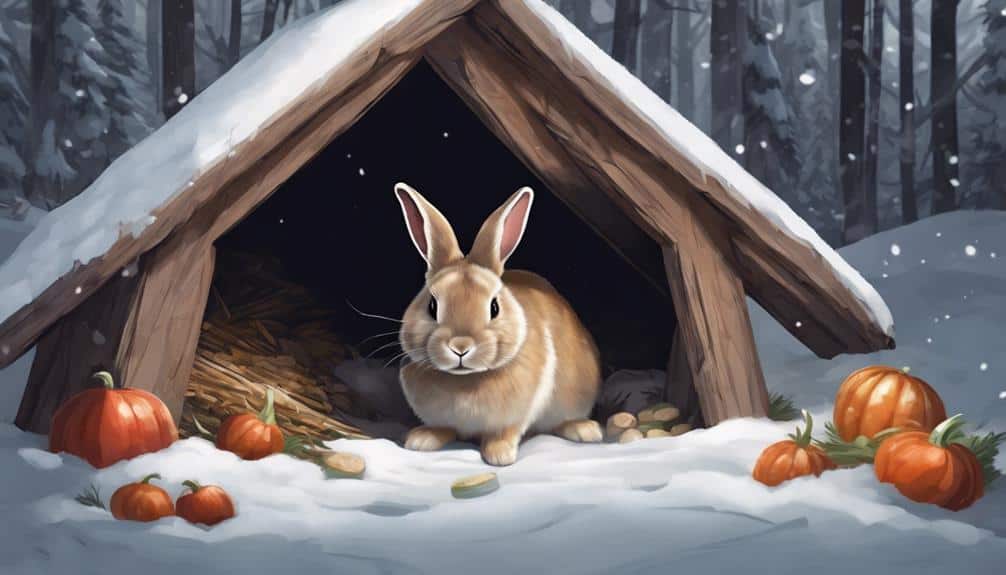
Bust the misconception that bunnies hibernate by understanding the scientific truth behind their winter behavior. Contrary to popular belief, bunnies don't hibernate during the cold winter months. This is because hibernation isn't a feasible survival strategy for these small mammals due to their need for continuous foraging.
In winter, rabbits stay warm by staying active, constantly on the move to find food and regulate their body temperature. Unlike some animals that enter a state of hibernation, bunnies rely on their ability to forage for sustenance.
Their winter adaptations include growing thicker fur to provide insulation against the cold and seeking sheltered spots to protect themselves from harsh weather conditions. By remaining active and vigilant in their search for food, bunnies guarantee their survival during the winter season.
Winter Survival Tactics of Bunnies
Despite the common misconception that bunnies hibernate, these small mammals employ strategic adaptations to survive the winter season. Wild rabbits don't hibernate during winter; instead, they rely on growing a thick winter coat for critical insulation against cold temperatures. This fluffy coat helps them retain body heat and stay warm while foraging for food.
In winter, bunnies actively seek out high-energy food sources to fuel their metabolism and maintain their body temperature. They often look for sheltered spots like burrows, dense vegetation, or even human-made structures to protect themselves from harsh weather conditions. It's crucial for bunnies to keep their fur dry as moisture can compromise their insulation, making it harder for them to stay warm.
Distinct Winter Adaptations of Bunnies
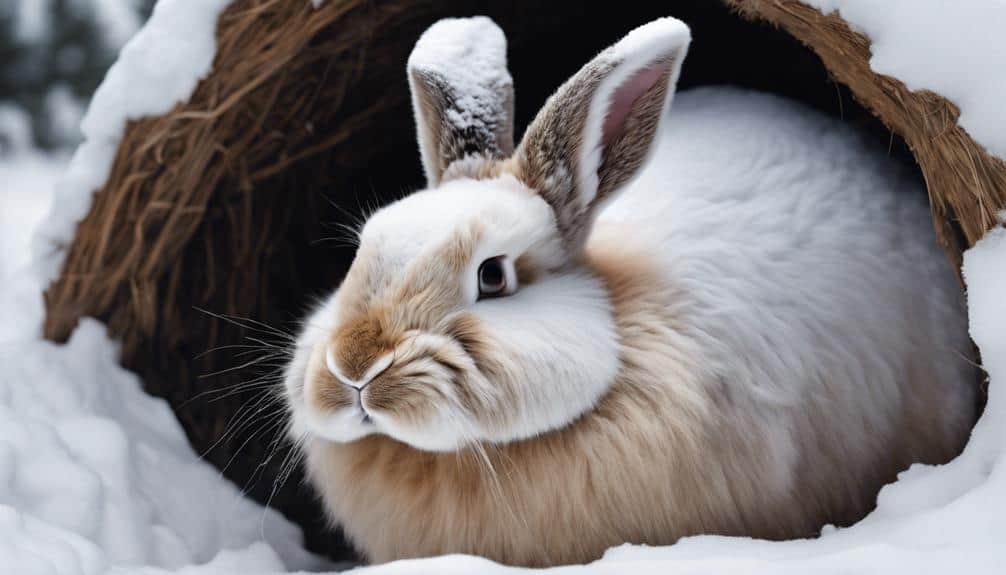
Bunnies develop thicker fur during winter to insulate themselves from the cold. They adapt their diet to include high-energy foods to sustain their activity levels.
Despite the challenges of limited food sources, they remain active in foraging to survive the harsh winter conditions.
Winter Fur Thickness
Growing thicker fur in winter, bunnies exhibit a distinct adaptation to withstand cold temperatures without hibernating. This thicker fur serves as insulation, providing warmth and protection for bunnies during harsh winter conditions. The winter fur growth is an important adaptation that enables bunnies to survive in cold weather by retaining body heat more effectively. This adaptation allows bunnies to remain active and forage for food even when temperatures drop greatly. With their thick winter fur, bunnies can brave the elements and thrive in the winter season.
- Thicker fur provides insulation against the cold.
- Winter fur helps retain body heat effectively.
- Adaptation enables bunnies to survive in harsh winter conditions.
- Allows bunnies to stay active and forage for food.
- Essential for thriving in the winter season.
Food Storage Habits
With their unique winter adaptations, bunnies showcase distinctive food storage habits to support their survival through the cold season. Bunnies do not store food for winter but rely on active foraging to meet their energy needs daily. They adapt to winter by changing their diet to high-energy food sources. Unlike some animals, bunnies lack the physiological capacity to store excess food. Their winter survival strategy involves continuous food search rather than hibernation.
| Food Storage Habits | Winter Adaptation | Energy Needs |
|---|---|---|
| Active Foraging | Changing diet | High-energy food sources |
| No food storage | Continuous food search | Physiological capacity lacking |
Decreased Activity Levels
Adapting to winter conditions, bunnies exhibit decreased activity levels as part of their distinctive winter adaptations. This behavior allows them to conserve energy and withstand the challenges of the cold season.
- Bunnies reduce movement to conserve energy.
- They seek shelter in insulated areas to stay warm.
- Thick winter fur helps them withstand low temperatures.
- Despite decreased activity, bunnies remain alert and vigilant.
- Bunnies forage for food to sustain themselves during winter months.
Understanding Bunny Behavior in Winter
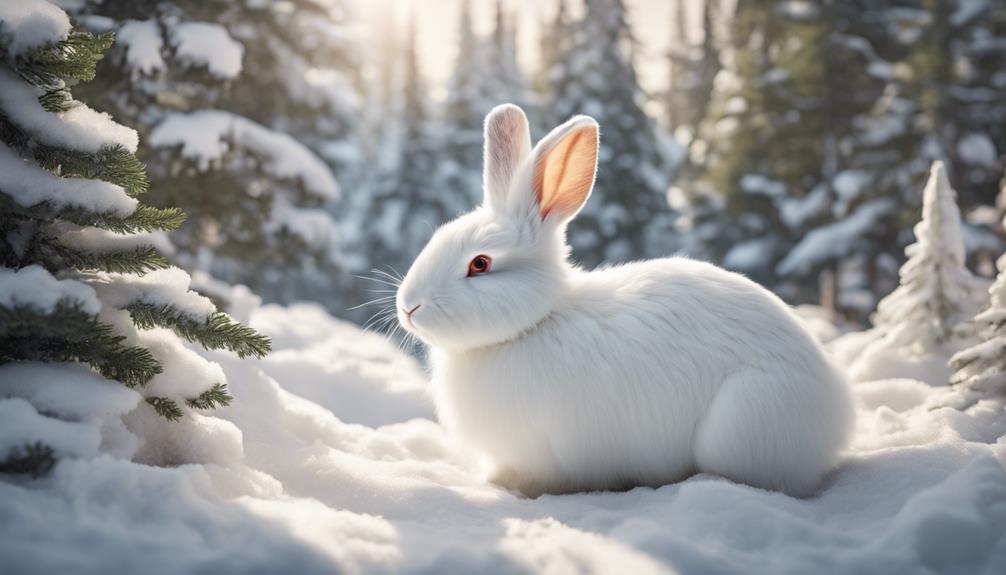
During winter, bunnies showcase fascinating behaviors to adapt to the cold season. They actively forage for food and seek shelter, staying alert and agile.
Understanding these winter habits sheds light on how bunnies navigate the colder months.
Winter Bunny Habits
When winter arrives, bunnies exhibit remarkable adaptations to cope with the cold temperatures and guarantee their survival. Understanding their winter habits is vital for their well-being:
- Thick Fur: Bunnies grow thicker fur in winter to provide better insulation against the cold.
- Shelter: They seek sheltered spots to stay warm and protected from harsh weather conditions.
- High-energy Foods: Adjusting their diet to high-energy foods helps them maintain their body temperature in the cold.
- Dry Fur: Keeping their fur dry is essential for insulation and protecting against freezing temperatures.
- Bunny Behavior: Observing and understanding bunny behavior in winter aids in providing the necessary care and support for their winter survival.
Bunny Winter Adaptations
How do bunnies modify their behavior in winter to make certain their survival in cold temperatures? Bunnies have several winter adaptations to cope with the harsh conditions. One key adaptation is growing thicker fur, providing better insulation against freezing temperatures. They also adjust their diet, consuming high-energy foods to compensate for limited food sources. Keeping their fur dry is essential for maintaining effective insulation. Bunnies remain active throughout winter, foraging for food and seeking shelter, as hibernation is not a common survival strategy for them. Below is a table summarizing some of the key adaptations bunnies make during winter:
| Winter Adaptations | Description | Importance |
|---|---|---|
| Thicker Fur | Provides insulation against cold | Helps retain body heat |
| Diet Adjustment | Consuming high-energy foods | Compensates for limited food sources |
| Remaining Active | Foraging for food and seeking shelter | Ensures survival by finding resources |
Bunny Hibernation Myths
Bunnies aren't creatures that hibernate during winter months; they actively engage in behaviors to guarantee their survival in the cold. Some common hibernation myths about bunnies include:
- Bunnies don't hibernate; they remain active throughout the winter months.
- Hibernation isn't a survival strategy for bunnies due to their need to constantly forage for food.
- Bunnies adjust to winter by growing thicker fur, seeking shelter, and adapting their diet.
- Winter challenges for bunnies include limited food sources, increased predator risk, and frostbite concerns.
- Keeping their fur dry is vital for bunnies to maintain insulation and survive winter temperatures.
Impacts of Winter Conditions on Bunnies
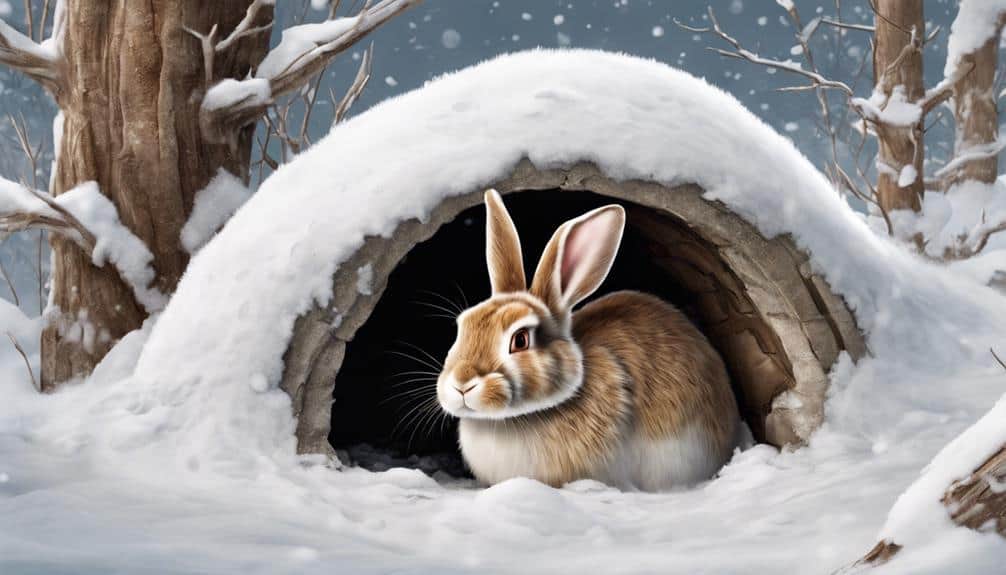
During the harsh winter months, the challenges posed by cold and snow greatly impact the survival of rabbits. Winter conditions make it harder for rabbits to find food, as snow covers their usual vegetation sources. This scarcity of food can lead to malnutrition and weaken the bunnies, making them more vulnerable to predators.
The snowy landscapes also increase the risk of predation since bunnies' white fur provides them with little camouflage. Additionally, freezing temperatures put rabbits at risk of frostbite, especially on their ears and feet, which can be detrimental to their health.
To combat the cold, rabbits rely on their fur for vital insulation. It's vital for them to keep their fur dry as dampness reduces its insulating properties, making it harder for them to stay warm. Understanding these impacts on rabbits during winter can help in taking appropriate measures to support their survival in challenging weather conditions.
Helping Wild Bunnies During Winter
To assist wild bunnies during winter, providing outdoor shelters with dry bedding is essential for their warmth and protection. Ensuring these shelters are well-insulated and free from drafts will help wild bunnies regulate their body temperature effectively.
Additionally, offering supplementary food sources like hay, leafy greens, and vegetables can supplement the limited winter diet of wild bunnies, aiding in their nutrition and energy levels. Avoiding the use of salt or de-icing chemicals near bunny habitats is important to prevent harm to their sensitive paw pads, which can easily get irritated.
Creating brush piles or leaving wild areas undisturbed provides natural shelter for wild bunnies seeking protection from harsh winter conditions, mimicking their natural habitats.
Caring for Pet Bunnies in Winter
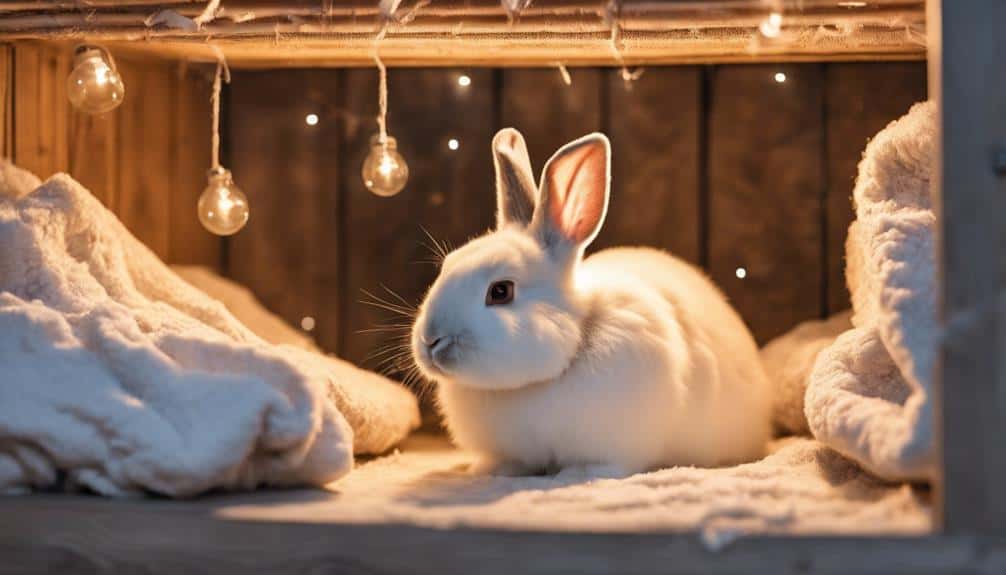
Ensuring proper insulation and fresh water availability are essential for safeguarding pet bunnies during the winter months. As temperatures drop, providing indoor shelter or an insulated hutch for your rabbit is vital to protect them from the cold and wind.
It's important to make sure that fresh water is available in a bowl and change it frequently to prevent freezing. Adding extra bedding and insulation to the hutch will help keep your pet bunny warm during the winter months.
Be vigilant for signs of hypothermia in your rabbit, such as cold ears and feet, reduced movement, and shallow breathing. While it's important to keep your bunny warm, avoid enclosing the entire hutch to allow for proper ventilation, balancing warmth with fresh air.
Frequently Asked Questions
What Do Bunnies Do in the Winter?
In winter, bunnies stay active, seeking food and shelter. They adapt by growing thicker fur, adjusting their diet to high-energy foods, and ensuring their fur stays dry. Predators pose a risk due to reduced visibility.
Do Indoor Bunnies Hibernate?
In your cozy abode, indoor bunnies skip hibernation. With controlled temps, constant food/water, playtime, they stay lively. No winter slumbers for these active furballs. Your care keeps them healthy and happy year-round.
How Do You Know if a Rabbit Is Hibernating?
To identify if a rabbit is hibernating, observe behavior changes like reduced activity, seeking warmth, and altered eating habits. Monitor for signs of hypothermia. In winter, rabbits conserve energy, regulate temperature, and focus on survival.
Why Don't I See Rabbits in the Winter?
You don't see rabbits in winter because they're experts at burrowing for warmth, adjusting their diet and sleep patterns, blending in with snow, and braving the cold without hibernating. These furry critters are winter survival pros!
Conclusion
As winter approaches, remember that bunnies don't hibernate! They rely on their thick fur, foraging skills, and shelter to survive the cold.
Just like a well-prepared hiker stocking up on supplies and finding a cozy campsite, bunnies must also adapt to the changing seasons.
By providing them with food and shelter, you can help these furry friends thrive during the winter months.
Stay informed and be a bunny hero this winter!


